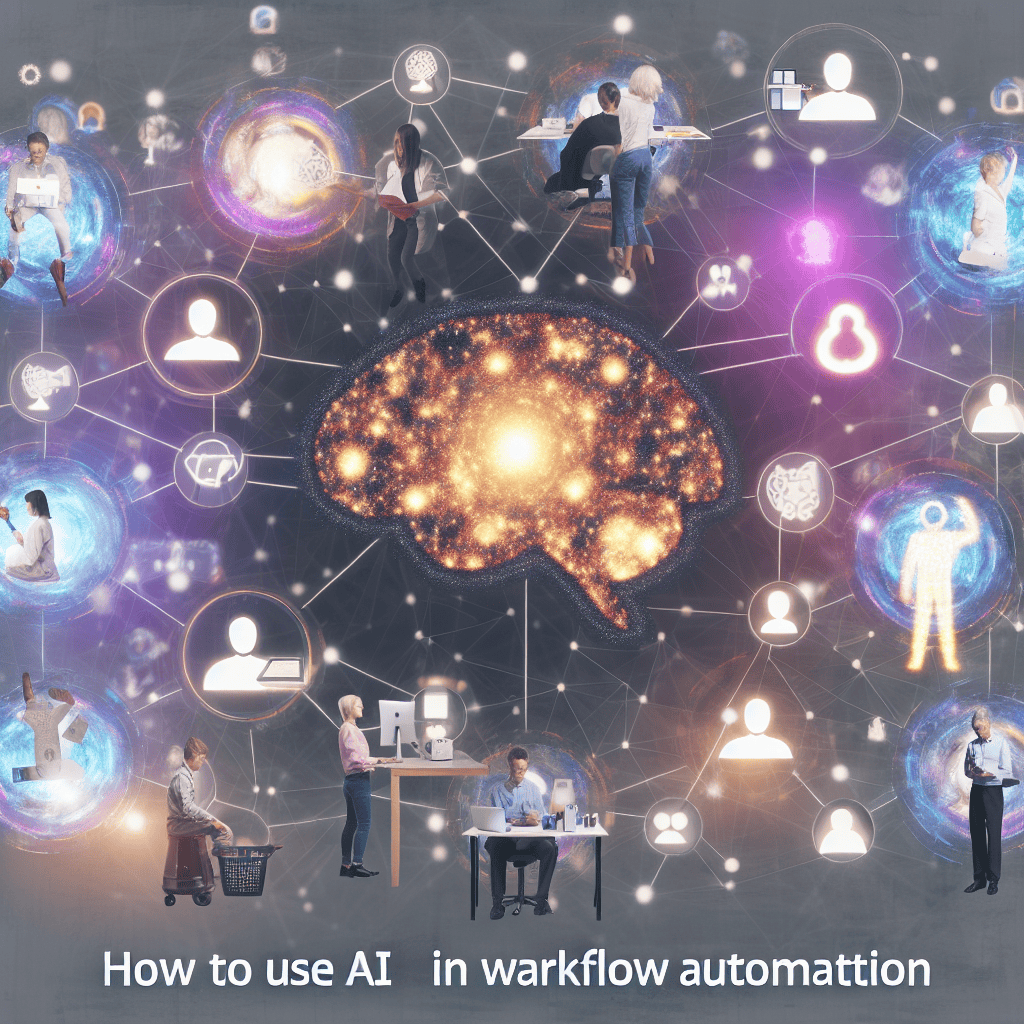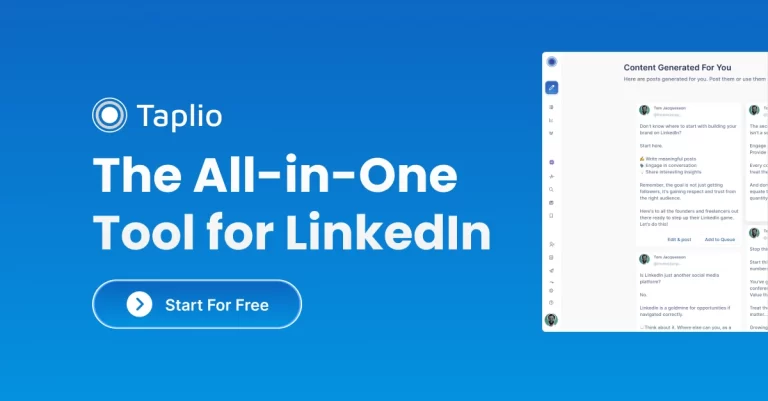Revolutionize Your Business: How to Use AI in Workflow Automation
Are you tired of drowning in repetitive tasks that waste your precious time and resources? Imagine a world where your business operates like a well-oiled machine, with streamlined processes and lightning-fast efficiency.
Unlock AI’s hidden potential and watch your productivity soar to new heights. Discover how AI-powered workflow automation can transform your business operations, freeing you and your team to focus on what truly matters: innovation, growth, and customer satisfaction.
Picture a workplace where manual data entry, tedious approvals, and time-consuming follow-ups are a thing of the past. Embrace AI automation and experience the freedom of streamlined processes, reduced errors, and improved decision-making. Say goodbye to bottlenecks and hello to a more agile and responsive business.
Don’t let your competitors leave you behind. Read our comprehensive guide to AI in workflow automation to take the first step toward a more efficient future.
What is AI in Workflow Automation?
AI in workflow automation represents a paradigm shift in how businesses streamline and optimize their processes. It involves leveraging artificial intelligence technologies to automate repetitive tasks, enhance decision-making, and foster greater efficiency throughout an organization.
At its core, AI workflow automation is about harnessing the power of machines to execute tasks that traditionally require human intervention. This includes everything from data entry and invoice processing to customer support interactions and complex decision-making.
The magic behind AI workflow automation lies in its key components:
- Machine Learning: This allows systems to learn from data, identify patterns, and make predictions without explicit programming. This capability is crucial for AI systems to improve their performance over time continuously.
- Natural Language Processing (NLP): NLP enables machines to understand and interpret human language, facilitating seamless interactions between humans and AI-powered systems. This is especially valuable for chatbots, voice assistants, and sentiment analysis tools.
- Robotic Process Automation (RPA): RPA automates repetitive, rule-based tasks by mimicking human actions. It excels at handling structured data and interacting with AI workflow automation software.
The critical distinction between AI and traditional automation lies in the ability to learn and adapt. While conventional automation follows predefined rules and instructions, AI automation systems can learn from new data and experiences, enabling them to handle more complex tasks, make informed decisions, and continuously improve performance.
This adaptability and intelligence set AI automation apart, making it a powerful tool for businesses seeking to unlock new levels of efficiency and innovation.
Why You Should Embrace AI Workflow Automation
Staying ahead of the curve demands more than hard work; it calls for intelligent solutions that maximize efficiency and unleash your true potential. Embracing AI workflow automation can revolutionize your business operations, providing benefits that translate to tangible success.
1) Dramatic increase in operational efficiency
AI automation handles mundane and repetitive tasks, freeing up your valuable time and resources. This streamlined approach allows you to accomplish more in less time, significantly boosting productivity and overall operational efficiency.
2) Significant reduction in human error
Manual processes are prone to mistakes, even with meticulous attention to detail. AI automation minimizes the risk of errors, ensuring accuracy and consistency across all your workflows. This leads to improved data quality, reduced rework, and increased customer satisfaction.
3) Ability to handle complex tasks and processes
AI systems can tackle intricate tasks once considered too complex for automation. This includes intelligent data analysis, natural language processing, and even decision-making based on real-time insights. Automating complex processes empowers your team to focus on strategic initiatives and high-value activities.
4) Improved decision-making through data analysis
AI automation systems can sift through vast amounts of data, uncovering hidden patterns and valuable insights that inform your decision-making. This data-driven approach helps you make more informed choices, identify growth opportunities, and mitigate potential risks.
5) Enhanced customer satisfaction
By automating routine tasks, AI frees your employees to focus on providing exceptional customer service. This translates to faster response times, personalized interactions, and improved overall customer experiences. Happy customers are loyal customers, and AI automation can be a key driver of customer satisfaction and retention.
Embracing AI workflow automation isn’t just about keeping up with the times; it’s about propelling your business into a new era of efficiency, innovation, and success.
How to Implement AI Workflow Automation: A Step-by-Step Guide
Transitioning to AI-powered workflow automation doesn’t have to be overwhelming. With careful planning and strategic implementation, you can seamlessly integrate AI into your business processes and unlock its full potential.
Let’s delve into a step-by-step guide to help you navigate this transformative journey.
1. Analyze Your Current Workflows

The first step towards successful AI implementation is deeply understanding your existing workflows. This involves meticulously examining your current processes to identify areas where AI can most impact them.
Take a close look at your daily operations and pinpoint tasks that are repetitive, time-consuming, or prone to human error. These are prime candidates for automation.
Create visual representations of your current processes, including each step, decision point, and potential bottleneck. This will help you identify areas for improvement and visualize how AI can streamline your operations.
Analyze your workflows to identify pain points and inefficiencies. Look for areas where manual intervention leads to delays, errors, or increased costs. AI automation can deliver the most significant benefits in these areas.
2. Set Clear Automation Goals
Once you’ve identified areas for improvement, it’s crucial to establish well-defined automation goals. This will help you stay focused and ensure your AI implementation efforts align with your business strategy.
Set measurable goals for your AI automation initiatives. For example, you might aim to reduce processing time by 50%, increase accuracy by 95%, or improve customer satisfaction scores by 10%. These specific objectives will help you track your progress and evaluate the success of your automation efforts.
Here’s a table outlining common automation goals that businesses may aim to achieve through workflow automation:
| Goal | Description | Expected Outcome |
| Increase Efficiency | Automate routine and repetitive tasks to speed up processes and reduce manual intervention. | Reduced operational costs and faster task completion. |
| Enhance Accuracy | Use AI to minimize human errors in data entry and processing. | Higher data quality and reliability. |
| Improve Decision Making | Implement AI-driven analytics to provide actionable insights and predictive analysis. | More informed and strategic business decisions. |
| Boost Productivity | Free up employee time from mundane tasks to focus on higher-value activities. | Increased employee satisfaction and output. |
| Scale Operations | Enable easier scaling of business processes to handle increased workload without extra headcount. | Enhanced capability to manage growth efficiently. |
| Enhance Customer Experience | Automate customer service processes like ticketing and responses to improve response times. | Improved customer satisfaction and retention. |
| Regulatory Compliance | Use automation to ensure compliance with industry regulations through consistent processes. | Reduced risk of compliance issues and penalties. |
This table serves as a guide to identifying specific goals for implementing AI workflow automation in business processes. It will help streamline operations and drive growth.
Ensure that your AI automation goals support your broader business objectives. Whether it’s improving efficiency, enhancing customer experiences, or driving innovation, your automation initiatives should contribute to your company’s overall success.
Not all processes are created equal. Prioritize automation efforts based on their potential impact on your business. Focus on processes with the most significant potential for cost savings, productivity gains, or customer satisfaction improvements. This strategic approach will help you maximize the return on your AI investment.
3. Choose the Right AI Workflow Automation Tools
The success of your AI automation initiative hinges on selecting the right tools and platforms. With many options available, conducting thorough research and choosing solutions that align with your specific needs and requirements is essential.
Explore various AI automation platforms and assess their features, capabilities, and ease of use. Look for platforms that offer a comprehensive suite of AI tools, including machine learning, natural language processing, and robotic process automation.
Here’s a table showcasing various types of automation tools that correspond to specific automation needs within a business environment:
| Automation Need | Type of Automation Tool | Example Tools |
| Task Automation | Robotic Process Automation (RPA) | UiPath, Automation Anywhere, Blue Prism |
| Data Entry Automation | Data Capture and Integration Tools | ABBYY FlexiCapture, Microsoft Power Automate |
| Workflow Automation | Business Process Management Software (BPM) | Nintex |
| Email Marketing Automation | Email Automation Platforms | Constant Contact, HubSpot |
| Customer Service Automation | Chatbots and AI Customer Support | Zendesk, Intercom, Drift |
| Data Analysis Automation | Business Intelligence and Analytics Tools | Tableau, Power BI, Google Analytics |
| Inventory Management | Inventory Automation Tools | Zoho Inventory, NetSuite, SAP |
| Human Resources Automation | HR Management Systems | BambooHR, Workday |
| Financial Processes | Financial Automation Software | QuickBooks, FreshBooks, Xero |
| Compliance Automation | Regulatory Compliance Management Software | Thomson Reuters Compliance, LogicGate |
| Social Media Automation | Social Media Management Tools | Hootsuite, Buffer, Sprout Social |
| Project Management | Project Management and Collaboration Software | Slack |
This table clearly outlines the types of automation tools suitable for different business needs, helping you choose the right technology to enhance efficiency and effectiveness in your operations.
Seamless integration with your existing systems is crucial for a smooth transition to AI automation. Choose platforms that offer robust integration capabilities, allowing you to connect your AI tools with your CRM, ERP, and other critical business applications.
As your business grows and evolves, your automation needs will change. Choose AI automation platforms that offer scalability and customization options, allowing you to adapt your workflows to meet future demands.
4. Start Small and Scale Up
Diving headfirst into AI automation can be tempting, but a gradual approach is often more prudent. By starting small and scaling up, you can minimize risks, learn valuable lessons, and ensure a smooth transition.
Choose a specific process or task to automate as a pilot project. This will allow you to test the waters, assess the effectiveness of your chosen AI tools, and identify any potential challenges.
Once your pilot project is up and running, monitor its performance closely. Analyze data, gather user feedback, and make necessary adjustments to optimize the automated workflow. This iterative approach will ensure that your AI automation initiatives deliver optimal results.
As you gain confidence and experience with AI automation, gradually expand your efforts to other processes. Prioritize tasks that offer the most significant potential for efficiency gains and cost savings.
Remember, AI automation is a journey, not a destination. You can ensure a successful and sustainable implementation by starting small and scaling up.
5. Train Your Team
The human element is critical to successful AI implementation. Invest in comprehensive training to equip your team with the knowledge and skills necessary to leverage AI automation effectively.
Ensure your team receives thorough training on the new AI tools and platforms. This includes hands-on experience, tutorials, and ongoing support to address any questions or challenges.
Change can be daunting, and some team members might be apprehensive about AI automation. Address their concerns openly and transparently, highlighting the benefits of AI automation, such as increased efficiency, reduced workload, and opportunities for professional growth.
Create a culture of open communication where team members feel comfortable providing feedback on the AI automation process. This valuable input can help you identify areas for improvement and ensure that your AI initiatives are continuously evolving to meet your business’s changing needs.
Top AI Workflow Automation Tools for Small Businesses
Navigating the vast landscape of AI workflow automation tools can be challenging, especially for small businesses with limited resources. To help you make an informed decision, let’s explore some popular AI-powered automation platforms, compare their features and pricing, and highlight case studies and success stories that showcase their real-world impact.
Overview of Popular AI-Powered Automation Platforms
The market is teeming with innovative AI automation solutions designed to cater to the unique needs of small businesses. Some of the leading contenders include:
- Zapier: A versatile platform that connects various apps and automates workflows between them, making it easy to streamline routine tasks without coding.
- Make (formerly Integromat): A powerful AI automation tool that offers advanced features like data parsing, custom functions, and scenario building, giving you greater control over your workflows.
- Power Automate: A Microsoft enterprise-grade automation platform that excels at complex integrations in Office 365, making it ideal for large businesses with ambitious automation goals.
- Workato: A cloud-native automation platform that offers a low-code environment for building and deploying workflows, enabling rapid development and scalability.
- Relay: An automation platform for IT and operations teams, offering a visual drag-and-drop interface and advanced features like error handling and version control.
Comparison of Features and Pricing
When evaluating AI workflow automation tools, consider the following factors:
- Ease of use: Look for platforms with intuitive interfaces and drag-and-drop functionality that make building and managing workflows without technical expertise easy.
- Integration capabilities: Ensure the platform seamlessly integrates with your existing apps and systems to enable smooth data flow and automate processes across your organization.
- Scalability: Choose a platform that can grow with your business, offering flexible pricing plans and the ability to handle increased data volumes and complexity as your automation needs evolve.
- Customization options: Look for platforms that allow you to tailor workflows to your specific requirements, ensuring maximum efficiency and flexibility.
- Pricing: Compare pricing plans carefully, considering factors like the number of users, tasks, and integrations included. Look for platforms that offer transparent pricing and flexible options to suit your budget.
Real-World Examples: AI Workflow Automation in Action
Let’s explore how real-world companies have leveraged AI workflow automation to achieve remarkable results:
Case Study 1: Amazon’s Intelligent Order Fulfillment
The e-commerce giant, Amazon, handles a massive volume of orders daily. Imagine the chaos if every step was manual. But they’ve mastered AI-driven automation:
- Automated Order Processing: AI algorithms extract order information from various sales channels, streamlining the process from purchase to shipment.
- Dynamic Inventory Management: AI-powered systems continuously track inventory levels, forecasting demand to prevent stockouts and overstocking, saving both time and money.
- Robotic Fulfillment Centers: Robots work with humans, optimizing picking, packing, and shipping processes for increased efficiency and speed.
Case Study 2: The Washington Post’s AI-Powered Journalism
Newsrooms operate at breakneck speeds. The Washington Post has embraced AI to enhance its content creation:
- AI Reporter: Their in-house AI tool generates data-driven stories, freeing up journalists for more complex reporting and analysis.
- Automated Content Tagging: AI classifies articles, making it easier for readers to find relevant content and improving the website’s searchability.
- Grammar and Style Checks: AI-powered tools ensure consistent, error-free writing across all their publications.
Case Study 3: JPMorgan Chase’s Streamlined Client Onboarding
For a financial institution like JPMorgan Chase, client onboarding used to be a paperwork-heavy process. AI has transformed it:
- Contract Intelligence Platform: Their AI tool reviews and extracts data from complex legal documents, saving countless hours of manual labor.
- Digital KYC (Know Your Customer): AI-powered systems verify client identities, reducing the risk of fraud and speeding up the onboarding process.
- Automated Client Communication: AI-driven chatbots provide instant responses to client queries, enhancing customer service and freeing up human agents for more complex tasks.
These examples showcase the power of AI workflow automation in diverse industries. Whether it’s an e-commerce giant, a leading newsroom, or a global financial institution, businesses are leveraging AI to gain a competitive edge. It’s time for you to explore the possibilities for your own business and embrace the transformative power of AI.
Overcoming Common Challenges in AI Workflow Automation
Embracing AI workflow automation can be transformative, but it’s important to be aware of and address potential challenges.
People naturally fear the unknown, especially when it comes to job security. Clear communication and training are essential to help your team understand the benefits of AI and how it will enhance their roles, not replace them.
While AI tools are becoming increasingly user-friendly, there’s still a learning curve involved. Invest in training and support to empower your team to use AI tools effectively.
Integrating AI into existing systems can sometimes encounter technical challenges. Work with experienced AI professionals and choose solutions that seamlessly integrate your current tech stack.
Future Trends in AI Workflow Automation
The world of AI is constantly evolving, and the future of workflow automation holds exciting possibilities.
Generative AI, capable of creating content and designs, and predictive analytics, which forecasts trends and behaviors, will further revolutionize workflow automation.
We’ll see AI solutions tailored to specific industries, addressing their unique needs and challenges.
AI will redefine job roles, creating new opportunities for those with the skills to leverage its power.
Taking it to the Next Level: Advanced AI Workflow Strategies
Ready to take your automation game even further? Explore these advanced AI workflow strategies:
- Implementing predictive maintenance: AI can analyze data from equipment and machinery, predicting potential failures before they happen, saving you time and money.
- Leveraging AI for personalized customer experiences: AI can analyze customer behavior and preferences, delivering personalized recommendations and experiences that drive engagement and loyalty.
- Exploring the potential of autonomous decision-making: AI can be trained to make decisions based on data and predefined rules, freeing up your team for more strategic work.
Alternatives to Full AI Workflow Automation
Full AI automation might not be the right fit for every business. Consider these alternatives:
- Hybrid approaches combining AI and traditional automation: Blend AI with traditional automation tools to achieve the right balance for your needs.
- Low-code and no-code automation platforms: These platforms allow you to build automated workflows without extensive coding knowledge, making automation more accessible.
- Outsourcing vs. in-house automation implementation: Weigh the pros and cons of each approach to determine which is best for your resources and expertise.
The world of AI workflow automation is full of exciting possibilities. By embracing these technologies and strategies, you can revolutionize your business, increase efficiency, and unlock new levels of success.
Final Thoughts on AI Workflow Automation
As we move into the future, AI workflow automation is no longer a luxury but a necessity for businesses that want to thrive.
The potential of AI workflow tools is immense, from streamlining mundane tasks to enabling strategic decision-making. While challenges exist, the benefits of increased efficiency, productivity, and innovation outweigh them.
By embracing AI and strategically implementing automation, you can position your business at the forefront of digital transformation and secure a successful future.






